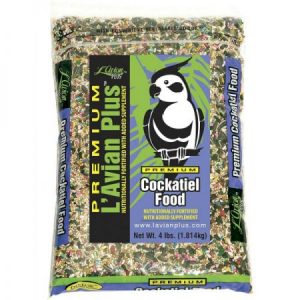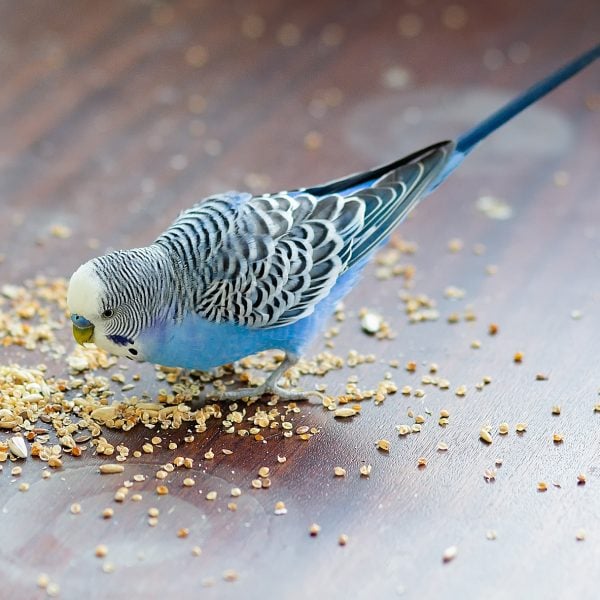Last Updated on by Mitch Rezman
Major Mitchell Cockatoo (above)
There’s a lot of talk today in the pet bird keeper community about how bad seeds are for our birds. That we should be introducing bird chops to our birds. If you are not familiar with bird chop – mix up about a pound of kale, beans, vegetables and fruit and serve to your bird. Most birds will eat less than 1% of that 1 pound of chop.
Then there’s the whole pellet argument. Pellets are engineered foods. They pack the most nutrition per kilo/calorie than any other form of food. We love seeing birds on pellets because we know that they don’t require additional vitamin supplementation which is usually the case with seeds.
Pellets are less messy than seeds, then again there are no pellet trees in the rainforest.
pellet blends also have bits of dried vegetables and dried fruit for an easy way to offer pellets and more with less mess.
is a wonderful blend of fruits veggies, seeds, and pellets where all of the seeds have had their hulls removed so it’s a very clean blend with minimal waste, virtually 100% of the mix can be eaten.
We get a lot of requests to talk about certain species which we try to do – last week it was Caiques. We’ve done posts on Amazons and on Lories but when I mention Australian grass parakeets most people say, “huh”?
The Bourkes parakeet is the exception in coloration in that Rosy Bourke’s have a brilliant pinkish tone – the other six species – Blue-winged parakeet – Elegant parakeet aka Rock parakeet – Orange-bellied parakeet – Scarlet-chested parakeet – Turquoisine parakeet – have to grass greenbacks which help them camouflage well.
The flip side is their colors are anything but boring. And I’m using them in this discussion to talk about seeds because the Australian grass parakeets feed entirely on the ground and mostly on (grass) seeds. They have lovely voices and rarely get into trouble.
It is not to say that we are suggesting that you don’t even try to convert them to pellets – just making the point that sometimes seeds are okay although you always want to introduce some form of vitamin and fresh food supplementation.
These small birds don’t have the red bull type of personality budgies do (Who are a cousin to grass parakeets) with all sorts of activity, they are a little more laid-back. Because they have short legs and small feet it’s best to leave them fully flighted because they are not built for lots of climbing. The tiny beaks have a hard time gripping many surfaces.
The most commonly known of these pet birds is the Bourkes parakeet which is relatively small, very calm, and usually quite tame.
Is this where we segway into what seeds are best, Mitch? For that, I will let all of you decide. I will start by delving into some bird food lines one at a time.
Our bird food category is quite varied so I know it spins some people around, especially the newbies. We going to start with the
This company has been producing birdseed since 1863 and we feel it’s one of the cleanest caged bird seeds available today. They are located in California’s sunny San Joaquin Valley, one of the world’s most fertile agricultural regions for premium-quality fruits, vegetables, nuts, grains, and seeds.
In addition to serving caged bird keepers, you will find their seed in veterinary schools, clinics, zoos, and aviaries.
One important note: Volkman uses NON-GMO white corn in their parrot food mixes.
Seeds are tested in an independent lab for the possible presence of E. coli and Streptococcus, then super cleaned, CO2 flushed, and packed in air-barrier bags to seal in freshness.
Volkman mixes contain over 50 essential vitamins, minerals, and amino acids bonded to pre-hulled seeds. Fruits and vegetables are human grade and seeds are germination tested for freshness. They use no dog food, cat food, meat, poultry, or fish by-products, animal fats, chemical preservatives, or artificial food colors.
Biggest swarm of budgies ever seeking seed with what they live on in the wild – video
We offer Volkman from their Avian Science Line which are nutritionally balanced bird diets fortified with vitamins, minerals, bonded amino acids, and select grains.
Meaning we have it available for finches, canaries, macaws, cockatoos, and everything in between.
All mixes contain exceptionally clean, all-natural, human-grade ingredients. And a tradition of trust for generations of healthy birds.
And they are all packed in re-sealable zip-lock poly bags for added convenience and use multi-layer lined bulk bags for added freshness. They were also the first bird company to introduce nitrogen-flushed bags for extended shelf life.
Written by Mitch Rezman
Approved by Catherine Tobsing
Author Profile
Latest entries
 The Traveling BirdJune 26, 2025Can You Name 5 Parrot Species That Are Living Wild in the USA?
The Traveling BirdJune 26, 2025Can You Name 5 Parrot Species That Are Living Wild in the USA? Bird BehaviorJune 26, 2025How is it Parrots Are Problem Solvers Social Animals and Even Use Tools?
Bird BehaviorJune 26, 2025How is it Parrots Are Problem Solvers Social Animals and Even Use Tools? Bird & Parrot AnatomyJune 25, 2025How a Tiny Chemical Modification Makes Parrots Nature’s Living Paintings
Bird & Parrot AnatomyJune 25, 2025How a Tiny Chemical Modification Makes Parrots Nature’s Living Paintings PigeonsJune 20, 2025How Do Parrots Thrive in Cities Outside Their Native Habitats?
PigeonsJune 20, 2025How Do Parrots Thrive in Cities Outside Their Native Habitats?





Michael Mattei
13 Oct 2024Next time I buy seed mixes, I’ll try Volkmans but I gotta say, I’ve been feeding Kula my scarlet, L’Avian Plus for many years as her mainstay and she loves it. I usually get a couple bags of it and 1 other new kind for a little variety. Fact is Mitch that I buy exclusively from you and trust anything you’re offering. I have tried pellets a few times and she won’t eat them.
Of course every day starts with her chopped assortment of fruits and mostly veggies. No seeds or nuts until mid afternoon. She’s going on 20!
JenX
13 Oct 2024Good topic. I just went to a parrot symposium featured Dr. Irene Pepperberg (author of Alex and Me, African grey cognition researcher) and Dr. Jan Hooimeijer (DVM, parrot behavioralist) and they spoke about the number one cause of death in captive parrots being malnutrition. All-seed diets were the main culprit, so I’m glad you’re not recommending (as a general rule except perhaps for certain grassland species) that this would be adequate. I like to feed my three (Grey, BF Amazon and Meyers) a quality pellet, some chop, and Higgins seed blend (California). I hope this is a nutritional diet and I’m glad that parrot nutrition continues to be a popular topic!